
I was wrong about the weather. Today was cool, as it has been, and for much of the day, rained on and off.
I was right about Prague; its tourist attractions are not a well-kept secret, and the city had more tourists than we’ve seen since St. Petersburg. I was even able to talk Chinese to a group from Beijing/Shanghai/Tianjin. There’s a reason that tourists flock to this city of around 1.2 million people: it has sights (buildings, especially medieval), food (it’s the home of Budvar, which gave the name to Budweiser–which cannot use that name here), and fun (the five-story night club is the destination for many tonight; others are going to see Swan Lake).
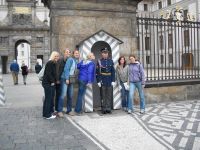 Even in the cool rain, the city is “cool.” Once the capital of Bohemia, Prague is now the capital of the 10 million citizens of the Czech Republic. Like some of the other countries we’ve visited, it was reconstituted after World War I, having gone in the 14th century from a Kingdom, to an ally of Poland, to a member of the Holy Roman Empire, to an important state in the Austrian-Hungarian Empire.
Even in the cool rain, the city is “cool.” Once the capital of Bohemia, Prague is now the capital of the 10 million citizens of the Czech Republic. Like some of the other countries we’ve visited, it was reconstituted after World War I, having gone in the 14th century from a Kingdom, to an ally of Poland, to a member of the Holy Roman Empire, to an important state in the Austrian-Hungarian Empire.
The history is almost as complicated after 1918. President Thomas Masaryk helped persuade Woodrow Wilson to recreate a state, Czechoslovakia, that figured prominently in the run-up to World War II. Hitler forced the Czechs to cede the predominantly German Sudetenland in the Munich agreement, then gobbled up what was left and created the protectorates of Bohemia and Moravia. Czechoslovakia’s fall behind the iron curtain was one of the milestones on the road to the Cold War. I can still remember the Warsaw Pact countries suppressing the Czech efforts at independence in 1968. After the end of the Soviet Union, Czechoslovakia reemerged as a democracy, and Slovakia split off by a vote in 1993.
Prague itself, perhaps because it fell to the Nazis before World War II, did not endure the destruction most European cities experienced during the War; that makes Prague’s medieval old town, like Krakow’s, a benchmark for the other old towns in Europe.
We visited the hill which contains the palace, once the home to kings, now the residence of the president of the Republic. Built originally around 900, the current incarnation was restored to the 16th century appearance. To be rich, Deng Xiao-ping once remarked, is glorious, and to be rich with taste is much better for posterity! The Bohemian kings had both, and the Hapsburgs did nothing to change it. The hill also has a major Gothic cathedral, with major lines that caused us to view it from the outside, and move on.
The lower medieval town may well attract even more tourists–it’s a shopping medley of souvenir stores, upscale jewelry, glass and clothing, and restaurants. Sascha and I had lunch in a recommended Czech restaurant, in a cellar with vaulted ceilings, low light, and high prices. But the duck and dumplings were delicious.
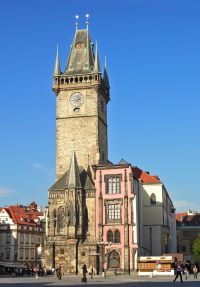 When we reconvened after lunch, our tour guide took us to the inside of the town hall, not usually on the tours, but nicely out of the rain. We’d passed a few town halls I’d like to have visited, so this one will have to provide a substitute for not having visited the others. They tend to be ornate, rather the palaces of the burghers and the bourgeoisie in the same way that the royal palaces satisfied the ornate tastes of royalty; the halls included Renaissance paintings, coats of arms, shields of the guilds, etc. Part of the town hall was used as a prison (early), and its underground storage took the place of refrigerators.
When we reconvened after lunch, our tour guide took us to the inside of the town hall, not usually on the tours, but nicely out of the rain. We’d passed a few town halls I’d like to have visited, so this one will have to provide a substitute for not having visited the others. They tend to be ornate, rather the palaces of the burghers and the bourgeoisie in the same way that the royal palaces satisfied the ornate tastes of royalty; the halls included Renaissance paintings, coats of arms, shields of the guilds, etc. Part of the town hall was used as a prison (early), and its underground storage took the place of refrigerators.
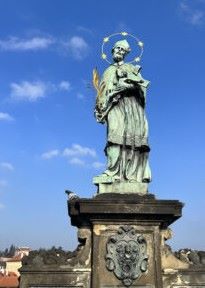
We then strolled through the old town to the Charles 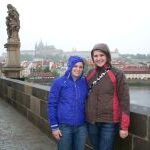 Bridge, constructed by Charles IV, the only Bohemian Holy Roman Emperor, who temporarily made Prague the capital of that hodge-podge confederation that someone quipped was neither holy, nor Roman, nor an Empire. The bridge may be the most photographed site in Prague, but was plagued (not a good word to use in Europe, which has suffered several severe plagues, leading to several monuments, including one we’ll see in Budapest) by reconstruction; as I understand it, it was the black plague in the 14th century that caused the end of Mongol rule in Europe. It’s still a place to stroll across and take pictures–look for one eventually on the website, with picturesque statues commemorating famous Czech mostly religious heroes.
Bridge, constructed by Charles IV, the only Bohemian Holy Roman Emperor, who temporarily made Prague the capital of that hodge-podge confederation that someone quipped was neither holy, nor Roman, nor an Empire. The bridge may be the most photographed site in Prague, but was plagued (not a good word to use in Europe, which has suffered several severe plagues, leading to several monuments, including one we’ll see in Budapest) by reconstruction; as I understand it, it was the black plague in the 14th century that caused the end of Mongol rule in Europe. It’s still a place to stroll across and take pictures–look for one eventually on the website, with picturesque statues commemorating famous Czech mostly religious heroes.
I wish I knew more about the religious history of the Czechs, because the city has churches that have a configuration I don’t think I’ve seen 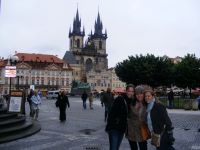 elsewhere–kind of a wedge-shaped steeple, surrounded by four turreted towers that are quite distinctive. In fact, the 30 years war (1618-48) started in Prague when some religious protesters were thrown out of the Castle window; defenestration, it’s called, and seems to have been a routine Czech punishment. (I don’t think it’s the inspiration for the Scout song with the refrain, “throw it out the window,” but I threatened defenestration as punishment if needed in this class). Jon Hus I think was an early critic of the medieval church and had a following that demanded reform; there are followers of Hus today, I understand, but he was burned at the stake.
elsewhere–kind of a wedge-shaped steeple, surrounded by four turreted towers that are quite distinctive. In fact, the 30 years war (1618-48) started in Prague when some religious protesters were thrown out of the Castle window; defenestration, it’s called, and seems to have been a routine Czech punishment. (I don’t think it’s the inspiration for the Scout song with the refrain, “throw it out the window,” but I threatened defenestration as punishment if needed in this class). Jon Hus I think was an early critic of the medieval church and had a following that demanded reform; there are followers of Hus today, I understand, but he was burned at the stake.
We had about two hours of free time, which I had hoped to use in exploring the old Jewish quarter in Prague. The city at one time had a thriving Jewish population, but during World War II, the Nazis destroyed it. Hitler had hoped to make a museum here to “The Final Solution,” which was his name for the Holocaust. The Nazis gathered Jewish artifacts from all over Europe, which remain here in a Jewish museum. However, when some of us went to get a ticket for the synagogues (one is a memorial listing names of all the Czech victims of the Holocaust), we found that today and tomorrow are Jewish holidays, and all of the Jewish Quarters were closed. Maybe next time.
Tomorrow, on to Vienna, for a quick visit to the capital of the Austro-Hungarian Empire, and one of the most fascinating cities and histories in Europe–or do I say that about every place we’ve visited?
Just wan to say your article is as astounding. The clarity on your post is just excellent and that i
can think you are a professional on this subject. Fine with your
permission allow me to grasp your RSS feed to stay updated with forthcoming post.
Thank you one million annd please keep up the rewarding work.